Embarking on a journey through Hanoi is an adventure that tantalizes all the senses, and for any food lover, the city’s culinary landscape is an absolute highlight. Visitors often ask us, “What are the must-try dishes?” While Phở Bò might be the most globally recognized, the world of Hanoi Specialty Food is vast and incredibly rich. It’s a tapestry woven from centuries of history, cultural influences, and the unique rhythm of life in Vietnam’s capital. From bustling street corners to hidden alleyways, exploring these iconic dishes is essential to truly experiencing the soul of Hanoi. Let’s dive into the flavors that define this ancient city.
Exploring Iconic Hanoi Specialty Food
Hanoi’s culinary identity is deeply intertwined with its history and geographical location. As the capital for over a thousand years, it has been a melting pot of flavors, refining dishes from across Vietnam and integrating foreign influences from China and France. This has resulted in a unique gastronomic tradition where simple ingredients are transformed into complex and memorable meals. The following list represents what we believe are the most famous and distinctive contributions to the world of Hanoi Specialty Food.
1. Phở Bò (Beef Noodle Soup)
Often hailed as Vietnam’s national dish, Phở Bò holds a particularly special place in Hanoi. While its origins are debated, with some tracing it back to the Nam Dinh province in the south of Hanoi, it was in Hanoi during the early 20th century that Phở truly found its refined form. Hanoian cooks elevated the beef broth to an art form, creating the deep, aromatic flavor that is now legendary. Many Vietnamese agree that while you can find Phở anywhere, the best flavor is reserved for Hanoi.
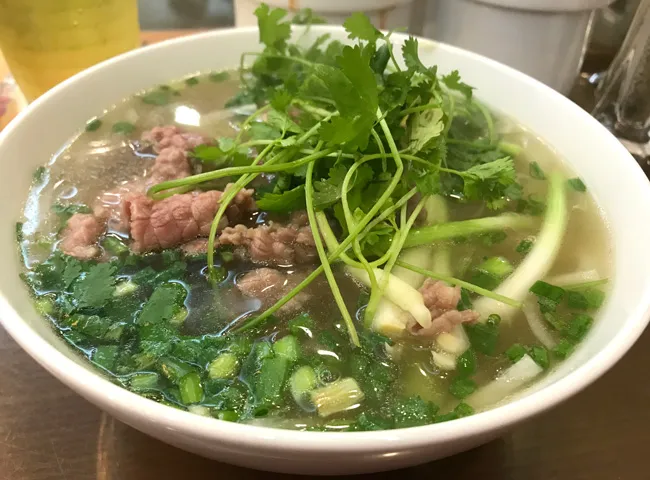 A steaming bowl of Phở Bò, a quintessential Hanoi Specialty Food
A steaming bowl of Phở Bò, a quintessential Hanoi Specialty Food
A classic bowl of Phở Bò features delicate rice noodles submerged in a rich, marrow-infused beef stock, topped with thinly sliced beef (often served rare or cooked), fresh ginger, and chopped spring onions. Each family or restaurant often guards its secret broth recipe, contributing to the dish’s diverse yet consistently high quality across the city.
Finding Your Perfect Amateur Astronomy Telescope – Expert Guide 2025
Discover the Best Michigan Places to Visit for Unforgettable Adventures in 2024
Discover the Top 11 nevada places to visit
Phở traditionally served as Hanoi’s most popular breakfast, fueling early commutes and morning routines. Today, however, its popularity means you can enjoy a bowl at any time of day. Finding your favorite Phở spot can be part of the adventure. Iconic establishments like Phở Gia Truyền on Bát Đàn Street are renowned for their broth, though be prepared for the inevitable queue! When trying Phở in Hanoi, don’t forget to customize your bowl with a squeeze of lime (or a dash of rice vinegar) and a bit of chili paste for that extra kick – a true Hanoian touch. It’s an undeniable part of the Hanoi Specialty Food experience.
2. Bún Chả (Grilled Pork Noodle Soup)
Following in the footsteps of Phở, Bún Chả is another beloved noodle dish that stands as a pillar of Hanoi Specialty Food. Vietnam is famous for its “strand and broth” dishes, and Bún Chả perfectly exemplifies this tradition. While both Phở and Bún use rice noodles, they differ in shape: Phở noodles are flat and wide like fettuccine, while Bún noodles are thin and cylindrical, resembling spaghetti.
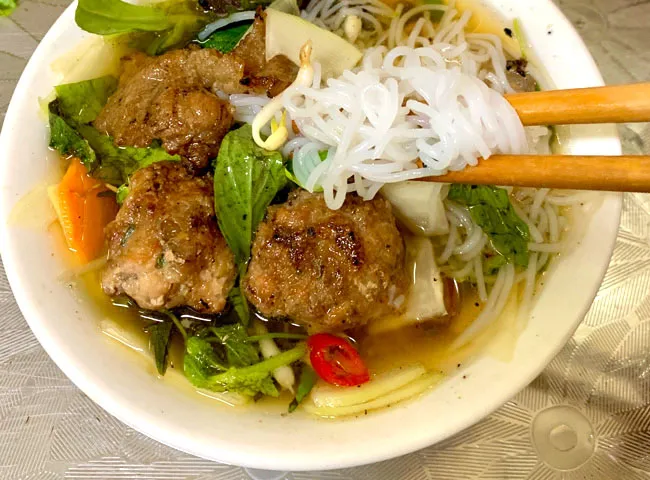 A bowl of Bún Chả with grilled pork patties and rice noodles, a popular Hanoi Specialty Food
A bowl of Bún Chả with grilled pork patties and rice noodles, a popular Hanoi Specialty Food
Bún Chả is served with a warm dipping sauce that’s a harmonious blend of diluted fish sauce, sugar, vinegar, and water. This flavorful liquid contains charcoal-grilled fatty pork slices (chả miếng) and seasoned pork patties (chả băm), along with pickled kohlrabi and carrot slices. It is accompanied by a generous plate of rice vermicelli (bún) and a variety of fresh herbs like perilla, coriander, and lettuce.
Often considered the most popular lunch dish in Hanoi, Bún Chả fills the midday air with the irresistible aroma of grilling pork. Spotting smoke signals from a street vendor is often your cue that delicious Bún Chả is nearby. The smoky char on the pork, combined with the refreshing herbs and tangy-sweet sauce, creates a complex and satisfying flavor profile. For an even more decadent meal, many opt to add crispy fried crab spring rolls (nem cua bể) to dip in the sauce. Adding fresh herbs and a touch of rice vinegar is key to unlocking the full flavor of this essential Hanoi Specialty Food.
3. Bún Thang (Like-Herbal-Medicine Noodle Soup)
Bún Thang is a more refined and complex noodle soup, showcasing the intricate culinary skills of Hanoi. The name itself hints at its complexity: “Bún” means rice vermicelli, and “Thang” refers to a dose of traditional herbal medicine, symbolizing the numerous ingredients (sometimes up to 20!) meticulously arranged in the bowl, much like a carefully composed medicinal prescription.
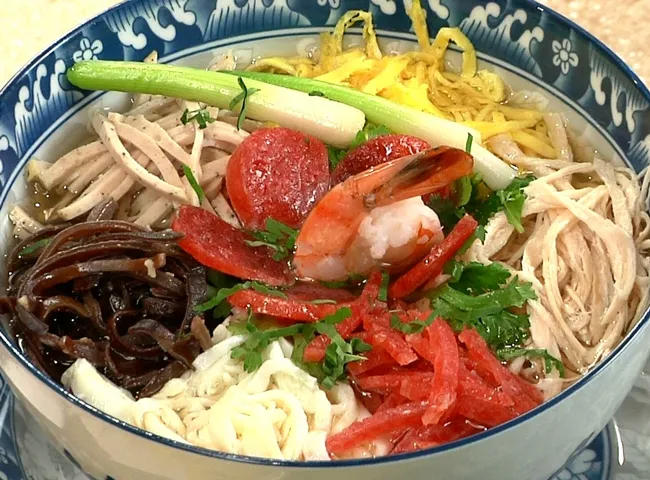 A delicate bowl of Bún Thang with various toppings, a refined Hanoi Specialty Food
A delicate bowl of Bún Thang with various toppings, a refined Hanoi Specialty Food
The base is a light yet flavorful chicken broth, occasionally enriched with pork. The toppings are what make Bún Thang visually stunning and texturally diverse: finely shredded chicken, delicate threads of Vietnamese ham (giò lụa), thin slices of scrambled egg crepe, rehydrated shiitake mushrooms, and a sprinkle of salted dried shrimp floss (ruốc tôm). The bowl is then garnished with fresh green onions, Vietnamese coriander (rau răm), crispy fried shallots, and a few thin slices of red chili. The result is a clear broth and a visually appealing bowl with a subtle, fragrant aroma.
Compared to the bold flavors of Phở or Bún Chả, Bún Thang is relatively mild. It is typically served with various condiments to allow diners to adjust the flavor to their preference. Lime wedges, rice vinegar, chili sauce, and notably, a small dollop of mắm tôm (shrimp paste) are often provided. Although shrimp paste has a pungent smell on its own, when stirred into the broth, it magically enhances the soup’s depth and gives it a pleasant, earthy undertone without being overpowering. Bún Thang is a testament to the subtle artistry found within Hanoi Specialty Food.
4. Bún Ngang (Muscovy Duck Noodle Soup)
If Phở is the breakfast king and Bún Chả reigns at lunch, Bún Ngang has earned its reputation as a popular street food option for dinner and late-night cravings in Hanoi. As mid-afternoon approaches, the characteristic signs for Bún Ngang begin to appear, often remaining open well past midnight, long after many other street food stalls have closed.
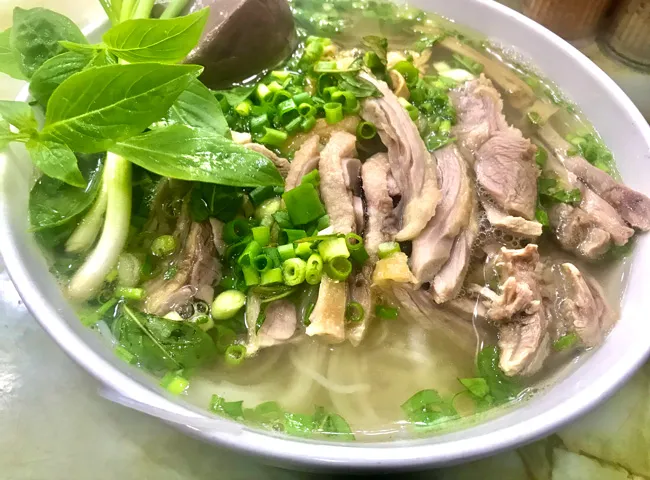 A bowl of Bún Ngang with duck and bamboo shoots, a favored Hanoi Specialty Food for evenings
A bowl of Bún Ngang with duck and bamboo shoots, a favored Hanoi Specialty Food for evenings
Bún Ngang features tender pieces of boiled Muscovy duck served with bamboo shoots (măng), all nestled in a flavorful broth with rice vermicelli noodles. Chopped spring onions add a touch of freshness. A variation, Mien Ngang, replaces the rice noodles with chewy cellophane noodles (miến), offering a different texture experience.
This dish is quite specific to Hanoi and relatively hard to find elsewhere in Vietnam. The Old Quarter is a particularly good place to seek out authentic Bún Ngang vendors who are known for boiling whole Muscovy ducks for hours to create a rich, slightly sweet broth. Trying Bún Ngang is a great way to sample a unique Hanoi Specialty Food that caters to the local evening crowd.
5. Bánh Mì (Vietnamese Baguette with Pâté)
The legacy of French colonization left an indelible mark on Vietnam, and one of the most delicious imports is undoubtedly the baguette, which the Vietnamese transformed into the now-famous Bánh Mì. While variations exist across the country, Hanoi’s Bánh Mì often adheres to a more traditional and perhaps slightly simpler combination of fillings compared to the South.
 A classic Bánh Mì sandwich, a fusion Hanoi Specialty Food
A classic Bánh Mì sandwich, a fusion Hanoi Specialty Food
A typical Hanoi Bánh Mì is built around a crispy, airy baguette generously filled with homemade pork liver pâté, often slices of Vietnamese ham (giò lụa) or roasted pork/chicken, and sometimes headcheese (giò thủ). These savory components are balanced with pickled carrot and daikon (đồ chua), fresh cilantro, cucumber slices, and often a squirt of chili sauce or mayonnaise. The combination of textures – the crusty bread, the smooth pâté, the crisp vegetables – and the explosion of flavors – savory, spicy, tangy, fresh – makes biting into a well-made Bánh Mì a truly satisfying experience.
Bánh Mì is widely available, from street carts to cafes and even hotel menus, making it a convenient and delicious option for breakfast or a quick snack. What was once primarily a simple street food staple for locals has gained international fame, becoming a sought-after item by food enthusiasts exploring Hanoi Specialty Food.
Looking for great Bánh Mì in Hanoi? A popular recommendation is Bánh Mì 25, known for its variety of fillings and consistent quality. It’s a great spot to experience this fusion classic. Pair it with a local Hanoi beer for a truly authentic street food moment.
6. Chả Cá (Grilled Turmeric-Marinated Catfish)
Perhaps the most symbolic dish born in Hanoi is Chả Cá. This unique dish, featuring grilled turmeric-marinated fish served tableside with dill and rice vermicelli, originated about 130 years ago with the Đoàn family. They reportedly served it to Vietnamese patriots during the French colonial period. The dish was so exceptional that the street where their restaurant was located was eventually renamed Chả Cá Street in its honor.
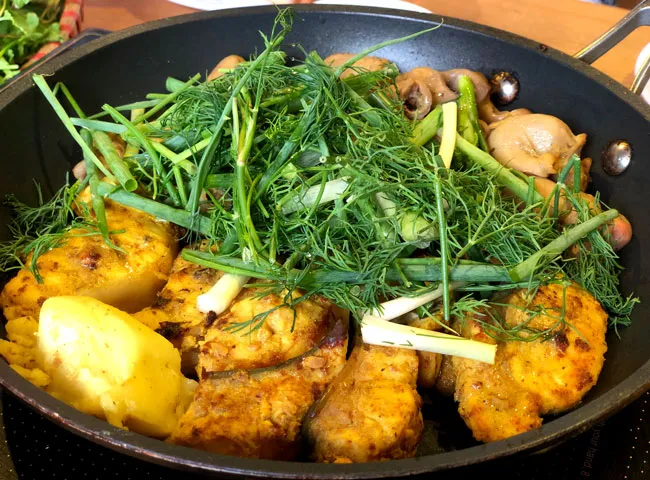 Chả Cá sizzling in a pan, a historical Hanoi Specialty Food
Chả Cá sizzling in a pan, a historical Hanoi Specialty Food
Unlike many other popular Hanoi foods found across numerous vendors, Chả Cá is a dish typically enjoyed at specific, often long-standing, family-run restaurants. The most famous is the original Chả Cá Lã Vọng at 14 Chả Cá Street, though others like Chả Cá Thăng Long are also highly regarded.
The experience of eating Chả Cá is part of its charm. Pieces of turmeric-marinated fish (usually catfish or snakehead fish) are brought to your table, already partially cooked, and then finished in a hot pan directly in front of you. Generous amounts of fresh dill and green onions are added to the pan to wilt just before serving. The sizzling fish, fragrant with turmeric and dill, is then combined in your bowl with white rice vermicelli, roasted peanuts, and a medley of other fresh herbs.
A dipping sauce, typically mắm tôm (shrimp paste) mixed with lime, chili, and a touch of sugar, accompanies the dish. If you want to try a Hanoi Specialty Food that is truly a product of Hanoi itself, Chả Cá is the one to choose.
7. Bánh Cốm (Young Sticky Rice Cake)
While many Vietnamese cities boast an iconic sweet treat, Hanoi’s is the exquisite Bánh Cốm. Made from young, green sticky rice (cốm) and sweet mung bean paste, this traditional cake is a cherished part of Northern Vietnamese culture. It is a customary offering at wedding proposals and other significant events. The cake is made using the most fragrant grains of young sticky rice, encasing a sweet, smooth filling of green beans often mixed with grated coconut and lotus jam.
 A traditional Bánh Cốm cake, a sweet Hanoi Specialty Food
A traditional Bánh Cốm cake, a sweet Hanoi Specialty Food
If you have a fondness for sticky rice or traditional sweets, Bánh Cốm is a must-try. While available in many shops, a visit to Hàng Than Street, known for its concentration of Bánh Cốm vendors, offers the most immersive experience. Renowned shops like Bánh Cốm Nguyễn Ninh, one of the original families making the cake on the street, are highly recommended.
Bánh Cốm is best enjoyed with a cup of traditional Vietnamese green tea, the slight bitterness of the tea balancing the cake’s sweetness. It’s a perfect souvenir or a thoughtful gift when visiting family and friends, embodying the simple, elegant sweetness that characterizes this particular Hanoi Specialty Food.
8. Bánh Cuốn (Rice Noodle Rolls)
Among the many contenders for Hanoi’s most iconic breakfast dish, Bánh Cuốn stands out alongside Phở. These delicate rice noodle rolls offer a unique texture and flavor profile, distinct from the city’s broth-based noodle soups.
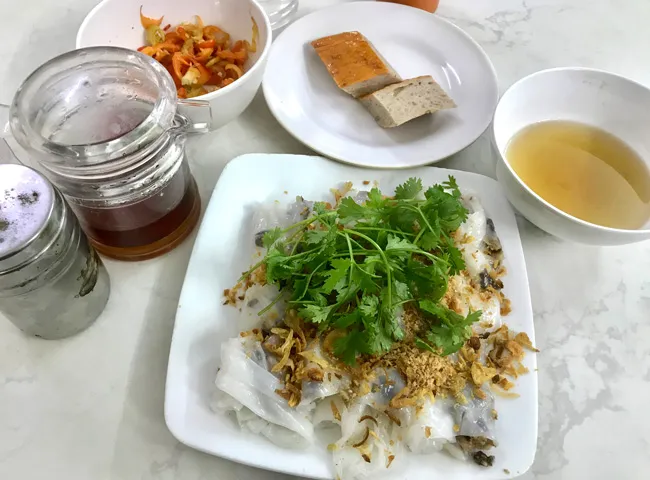 Steamed Bánh Cuốn with fillings, a popular Hanoi Specialty Food for breakfast
Steamed Bánh Cuốn with fillings, a popular Hanoi Specialty Food for breakfast
Bánh Cuốn is made by steaming a thin, wide sheet of fermented rice batter over a cloth stretched across a pot of boiling water. This process creates an incredibly delicate and translucent wrapper. Each sheet is then typically filled with a savory mixture of seasoned ground pork, finely minced wood ear mushrooms, and fried shallots. The finished rolls are lightly scattered with crispy fried shallots and served with fresh herbs like cilantro or mint.
A plate of Bánh Cuốn is usually accompanied by slices of Vietnamese pork sausage (chả lụa) and a dipping sauce. The sauce is traditionally a nuanced mixture of fish sauce, sugar, lime, and often a drop of cà cuống essence (giant water bug essence), which imparts a unique aroma. Eating Bánh Cuốn evokes nostalgic memories for many Hanoians, often associated with simple market mornings. It’s a light yet flavorful introduction to Hanoi Specialty Food that showcases the elegance of Vietnamese rice-based cuisine.
9. Cà Phê Trứng (Egg Coffee)
While Vietnam is globally recognized as a major coffee producer, the Hanoi Specialty Food scene offers a unique take on the beverage: Cà Phê Trứng, or egg coffee. This inventive drink was born out of necessity during the lean times of the resistance war in Hanoi. Mr. Giang, the founder of the now-famous Café Giang, created this drink by whisking egg yolk with sweetened condensed milk to substitute for fresh milk, which was scarce. He likely didn’t anticipate that his creation would become a must-try iconic drink.
 A cup of Cà Phê Trứng with its creamy foam top, a unique Hanoi Specialty Food drink
A cup of Cà Phê Trứng with its creamy foam top, a unique Hanoi Specialty Food drink
A cup of Cà Phê Trứng features rich Vietnamese coffee topped with a thick layer of creamy, whipped egg yolk and condensed milk mixture. The contrast between the bitter coffee and the sweet, custardy foam is delightful. Many first-timers liken the taste to a liquid tiramisu or a dessert in a cup.
Café Giang at 39 Nguyễn Hữu Huân Street is the original establishment, founded in 1946 by Mr. Giang. While they serve the classic egg coffee, they have also expanded to offer variations like egg matcha, egg beer, and even egg ice cream, proving you don’t need to be a coffee drinker to enjoy this famous local spot and unique Hanoi Specialty Food beverage.
10. Kem Tràng Tiền (Tràng Tiền Ice Cream)
For many Hanoians, Kem Tràng Tiền isn’t just ice cream; it’s a cultural landmark and a taste of childhood. Opened in 1958, this state-owned ice cream shop is located right in front of the iconic Hanoi Opera House and has been a beloved destination for generations.
 People enjoying Kem Tràng Tiền, a nostalgic Hanoi Specialty Food treat
People enjoying Kem Tràng Tiền, a nostalgic Hanoi Specialty Food treat
Especially popular in the evenings and on weekends, Kem Tràng Tiền is known for its simple, classic flavors and unique ordering system – you choose your flavor, pay at one counter, and pick up your treat from the freezer window. Options typically include coconut, chocolate, green bean, and young sticky rice (cốm) flavor. The ice cream is known for being slightly icy rather than overly creamy, offering a refreshing coolness, particularly welcome in Hanoi’s often humid climate.
While perhaps not gourmet by international standards, the appeal of Kem Tràng Tiền lies in its nostalgia, its affordability, and the sheer experience of joining the crowds enjoying a simple pleasure. It’s a classic way to end an evening stroll or a food tour, providing a sweet and cooling conclusion to your exploration of Hanoi Specialty Food.
Frequently Asked Questions About Hanoi Specialty Food
What is considered the most famous Hanoi Specialty Food?
While opinions vary, Phở Bò (Beef Noodle Soup) is arguably the most famous Hanoi Specialty Food and is often considered Vietnam’s national dish, perfected in Hanoi.
Where is the best place to try authentic Hanoi Specialty Food?
Authentic Hanoi Specialty Food can be found throughout the city, from bustling street stalls in the Old Quarter to established family-run restaurants. Specific famous locations are often mentioned for particular dishes, such as Bát Đàn street for Phở or Hàng Than street for Bánh Cốm.
Is Hanoi Specialty Food spicy?
Some Hanoi Specialty Food dishes can be spicy, but many are served with chili sauce or fresh chilies on the side, allowing you to adjust the heat level to your preference. Dishes like Bún Chả or Phở are not inherently spicy.
Can vegetarians find options in Hanoi Specialty Food?
While many traditional Hanoi Specialty Food dishes feature meat or fish, vegetarian versions of popular dishes like Phở (Phở Chay) and Bánh Cuốn (Bánh Cuốn Chay) are increasingly available, especially in areas catering to tourists.
Exploring the Hanoi Specialty Food scene is more than just eating; it’s a deep dive into the city’s history, culture, and daily life. Each dish tells a story, offering a flavorful connection to the soul of Hanoi. We hope this guide inspires you to savor every bite on your next visit!
